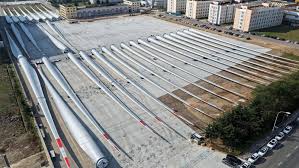By Li Hongxing, People’s Daily
Two recent developments in wind turbine blade technology have sparked considerable public interest. First, blade lengths have increased dramatically – from just over 30 meters to more than 150 meters – significantly boosting the power-generating capacity of individual turbines. Second, companies are pioneering innovative ways to recycle decommissioned blades, particularly those from the first generation of turbines now nearing the end of their service life. These retired blades are being transformed into eco-friendly products such as pallets and pedestrian walkways.
As blades grow longer and industry chains expand, new commercial models and development trajectories are emerging. During a recent visit to a blade manufacturing facility, a striking question arose as we stood before a massive 100-meter blade in production: “If blades keep getting larger and production volumes increase, won’t the market eventually become saturated? Where will future growth come from?”
A company representative expressed no such concerns. The firm had already mapped out a comprehensive post-production value chain, covering areas such as turbine operations, maintenance, and blade recycling – each representing a substantial market opportunity in its own right. This strategic expansion and diversification of business models demonstrates how companies are innovating to overcome perceived market limitations and sustain growth.
This raises a broader question: Markets exist – but how can companies access new growth opportunities? Instructive parallels can be drawn from three diverse products across different sectors.
Consider, for instance, the case of bottled water.
In the western mining area of Shuangyashan Mining Company in northwest China’s Heilongjiang province, high groundwater levels once posed serious challenges to coal mining. Guided by a commitment to green development and supported by technological innovation, the company implemented a “drain – purify – reuse” model. The purified water now serves multiple purposes: production processes, dust suppression, irrigation, and even a new mineral water product line. This initiative generates nearly 10 million yuan ($1.41 million) in annual revenue, transforming what was once hazardous mine water into a source of green vitality.
The question remains: Where is the market? Growth emerges through transformation. Whether upgrading traditional sectors or reshaping emerging ones, companies that refuse to settle and persistently pursue improvement and innovation discover new pathways with every problem solved and unlock fresh potential with every reform.
Development resembles digging a well, and the market is the spring: those willing to explore new directions and apply fresh thinking to familiar territory will always find a steady flow of opportunity.
Consider the case of a bus route. Recently, Shanghai J.Y Ba-Shi Passenger Transport (Group) Co., Ltd. launched a customized service enabling elderly passengers to travel directly to local food markets. This “food-focused” route has become a new offering supporting leisure and consumption. As high-speed rail expands and traditional long-distance coach services decline, tailored routes like these have gained popularity across the Yangtze River Delta. Their success lies in accurately identifying consumer needs, carefully designing routes, improving service quality, and strengthening stakeholder collaboration.
Where do such opportunities originate? They require attention to both regional trends and granular shifts. Young and old alike cherish the small joys of everyday life and appreciate accessible escapes close to home. When companies understand and meet these emotional needs, they tap into hidden market potential. Experience shows that through market-driven integration of cultural tourism, local products, and transportation resources, localized demand can become a growth driver, and regional micro-circulation can stimulate broader economic flows.
Finally, consider a screen protector. A company in central China’s Hunan province produces tempered glass screen protectors sold in 68 countries and regions, capturing 30% of the global market. Their competitive edge? Take fingerprint recognition sensitivity: through sustained R&D, they reduced protective film thickness from 0.33 millimeters to just 0.1 millimeters. By refining technology and strengthening their product, they generated tangible growth momentum.
The key lies not only in external drivers but in building inherent capabilities. From a single company to an entire region – and indeed, in forging a new development paradigm – continuous enhancement of internal resilience unlocks greater vitality. The stronger a company’s self-driven strength, the more competitive it becomes. When countless market entities thrive, they inject lasting momentum into China’s high-quality development.
China’s economy possesses a stable foundation, numerous advantages, remarkable resilience, and vast potential. The fundamental conditions and long-term positive trajectory supporting its growth remain unchanged.
Within transformation lies opportunity;in microeconomic circulation, hidden potential; through inner strength, sustainable growth. Rooted in practical experience and looking ahead, China is steadily opening new frontiers for development.
Three products that reveal China’s secret in exploring new frontiers of growth

Leave a Reply